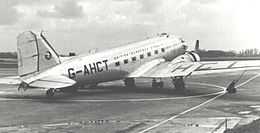1949 Manchester BEA Douglas DC-3 accident
|
A British European Airways Douglas DC-3 Dakota freighter in 1951 similar to the accident aircraft. | |
| Accident summary | |
|---|---|
| Date | 19 August 1949 |
| Summary | Pilot error |
| Site | Oldham, Lancashire, England, United Kingdom |
| Passengers | 29 |
| Crew | 3 |
| Injuries (non-fatal) | 8 |
| Fatalities | 24 |
| Survivors | 8 |
| Aircraft type | Douglas DC-3 |
| Operator | British European Airways |
| Registration | G-AHCY |
| Flight origin | Nutts Cormer Airport, Belfast, Northern Ireland, United Kingdom |
| Destination | Manchester Airport, England, United Kingdom |
The 1949 Manchester DC-3 accident occurred when a twin-engined British European Airways Douglas DC-3 (registration: G-AHCY) crashed at Oldham, near Manchester after a flight from Belfast. The accident killed 24 of the passengers and crew on board.[1]
The aircraft had first flown in 1944,[1] and was captained by F. W. Pinkerton, a former RAF serviceman who, as a sergeant, had been posted missing during World War II.[2][3] The airline was government-owned.[4]
Accident
The aircraft took off from Belfast Nutts Corner Airport at 10:58 on a short-haul flight to Manchester Airport, with twenty-nine passengers and either three or four crew members on board. US newspaper reports, using agency reports filed soon after the incident, favour the former number of crew;[1] Flight Magazine, reporting a little time later, favoured the latter.[3]
An hour after take-off, at 11:59, the last radio contact with the crew occurred and about one minute later the aircraft crashed. It was flying at approximately 1,350 feet (410 m) when it hit a mist-covered hill (53°31.240′N 1°58.733′W / 53.520667°N 1.978883°W) at Wimberry Stones, near to the Chew Valley at Saddleworth, Oldham, 15 miles (24 km) from Manchester Airport. Contact was made approximately 20 feet (6.1 m) from the summit.[3] The aircraft broke up and caught fire. Twenty-one passengers and all the crew members died, leaving eight survivors.[1][5]
The dead passengers consisted of eleven women, six men and four children, three of whom were aged under two years;[3] the crew were all male. All but two of the dead died at the scene.[6] The injured were treated at Oldham Infirmary.[4] The rescue was hampered by the bad weather and remote location of the crash site. Workers from a paper mill approximately 0.75 miles (1.21 km) away formed a human chain to carry the injured from the hillside to lower ground and a doctor at the scene said
I found bodies scattered all over the place. There were a few survivors lying groaning on the hillside but some of them died before I could attend to them.I have been a doctor since 1914 and served in both wars, but this was the worst sight that I have ever seen.[7]
The cause of the accident was an error in navigation, incorrect approach procedure and failure to check the position of the aircraft accurately before the descent from a safe height.[1]
An hour later, a Proctor light aircraft crashed on a test flight in mist at Baildon in Yorkshire, approximately 40 miles (64 km) away. All four of its passengers died.[5][8]
References
- ↑ 1.0 1.1 1.2 1.3 1.4 "Accident Description". Aviation Safety Network. Retrieved 2011-02-12.
- ↑ - 1395.html "Roll of Honour - Royal Air Force". Flight. 1943-05-27. p. 567. Retrieved 2011-02-14.
- ↑ 3.0 3.1 3.2 3.3 "B.E.A. Dakota crash". Flight. 1949-08-25. p. 227. Retrieved 2011-02-14.
- ↑ 4.0 4.1 Associated Press (1949-08-20). "British plane crash kills 24". Pittsburgh Post-Gazette. Retrieved 2011-02-12.
- ↑ 5.0 5.1 Associated Press (1949-08-19). "British plane crashes, 22 persons killed". The Rock Hill Herald. Retrieved 2011-02-12.
- ↑ Associated Press (1949-08-20). "Plane hits British hill, 21 killed". Schenectady Gazette. Retrieved 2011-02-12.
- ↑ U.P. (1949-08-19). "27 killed in plane crashes". Greensburg Daily Tribune. pp. 1, 12. Retrieved 2011-02-12.
- ↑ Associated Press (1949-08-19). "26 Britons perish in 2 plane crashes". The Victoria Advocate. Retrieved 2011-02-12.
Further reading
- "Dakota air crash near Oldham". British Pathé. Retrieved 2011-02-12. - short film clip of the scene after the crash
| ||||||||||
